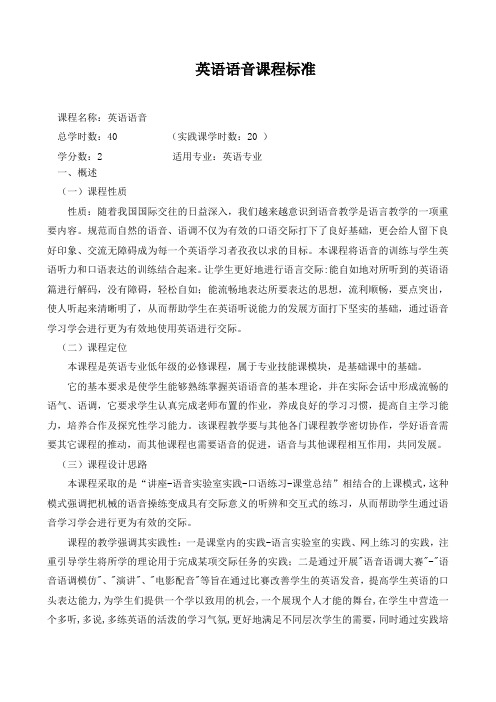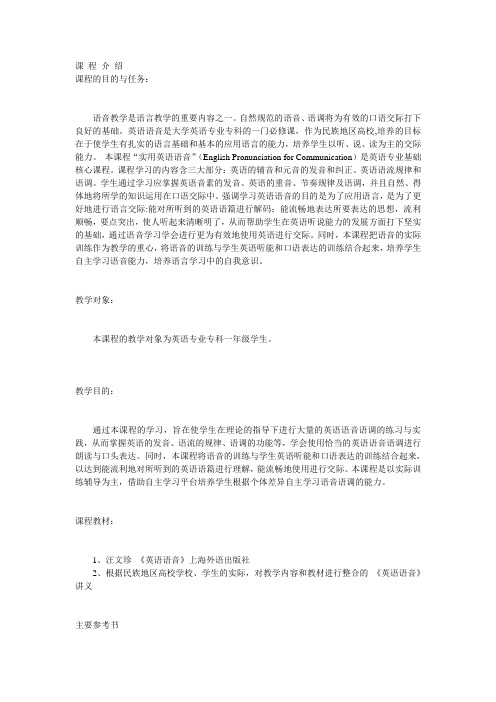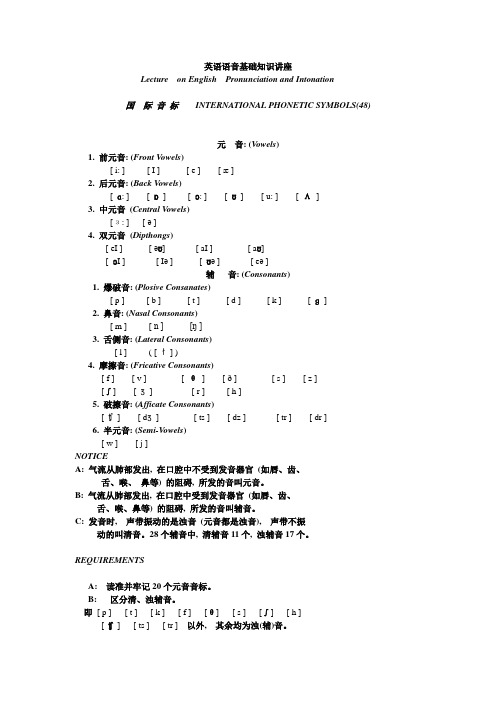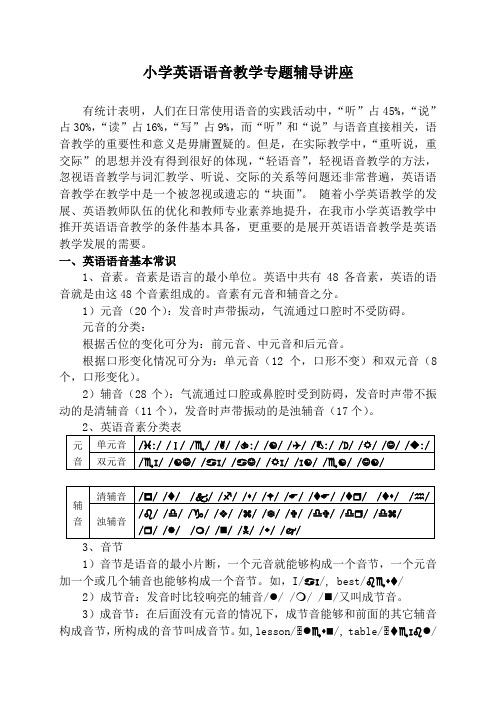英语语音培训讲座(课件)
《英语语音》课程标准-教学大纲-对应刘森教材-上海外语教育出版社

英语语音课程标准课程名称:英语语音总学时数:40 (实践课学时数:20 )学分数:2 适用专业:英语专业一、概述(一)课程性质性质:随着我国国际交往的日益深入,我们越来越意识到语音教学是语言教学的一项重要内容。
规范而自然的语音、语调不仅为有效的口语交际打下了良好基础,更会给人留下良好印象、交流无障碍成为每一个英语学习者孜孜以求的目标。
本课程将语音的训练与学生英语听力和口语表达的训练结合起来。
让学生更好地进行语言交际:能自如地对所听到的英语语篇进行解码,没有障碍,轻松自如;能流畅地表达所要表达的思想,流利顺畅,要点突出,使人听起来清晰明了,从而帮助学生在英语听说能力的发展方面打下坚实的基础,通过语音学习学会进行更为有效地使用英语进行交际。
(二)课程定位本课程是英语专业低年级的必修课程,属于专业技能课模块,是基础课中的基础。
它的基本要求是使学生能够熟练掌握英语语音的基本理论,并在实际会话中形成流畅的语气、语调,它要求学生认真完成老师布置的作业,养成良好的学习习惯,提高自主学习能力,培养合作及探究性学习能力。
该课程教学要与其他各门课程教学密切协作,学好语音需要其它课程的推动,而其他课程也需要语音的促进,语音与其他课程相互作用,共同发展。
(三)课程设计思路本课程采取的是“讲座-语音实验室实践-口语练习-课堂总结”相结合的上课模式,这种模式强调把机械的语音操练变成具有交际意义的听辨和交互式的练习,从而帮助学生通过语音学习学会进行更为有效的交际。
课程的教学强调其实践性:一是课堂内的实践-语言实验室的实践、网上练习的实践,注重引导学生将所学的理论用于完成某项交际任务的实践;二是通过开展"语音语调大赛"-"语音语调模仿"、"演讲"、"电影配音"等旨在通过比赛改善学生的英语发音,提高学生英语的口头表达能力,为学生们提供一个学以致用的机会,一个展现个人才能的舞台,在学生中营造一个多听,多说,多练英语的活泼的学习气氛,更好地满足不同层次学生的需要,同时通过实践培养学生分析问题和解决问题的能力,从而使课程达到最佳的教学效果。
初中英语新课标,新中考(英语教研组新课标学习活动主题讲座培训课件)

• 依据:“The facts shown that students were more active after carrying out the ‘Double Reduction’ policies.” Said Fan.
the students interested in science. 85. I feel excited about the lesson.
英语教研组新课标学习活动主题讲座培训课件
第二节(书面表达)
英语教研组新课标学习活动主题讲座培训课件
英语中考的可能趋势
2023年,中考全省统一命题 听力和口语结合,人机对话
Thanks
新中考“新”在哪儿?
• 全科开考,分值和计分方式变化 • 命题形式与高考衔接 • 开放性的试题增多,越来越灵活 • 命题紧扣时代热点 • 体现中国元素和地方特色
英语教研组新课标学习活动主题讲座培训课件
新中考
一、考试题型的变化 1.听力:图片理解,六选五
英语教研组新课标学习活动主题讲座培训课件
2.阅读理解 (1)短文中填句子,考查学生的逻辑思维能 力
英语教研组新课标学习活动主题讲座培训课件
英语教研组新课标学习活动主题讲座培训课件
2022-2022第一学期九年级质量监测试题 试题的新变化
1.考查学生看的内容明显增多
英语教研组新课标学习活动主题讲座培训课件
英语教研组新课标学习活动主题讲座培训课件
推理判断题(C篇)
• What’s Fan Biao’s attitude to the “Double Reduction ” policies?
(学校)基于英语学习活动观的初中英语教学实践详解(中小学教育教研讲座教学培训课件)

Thank you!
从文体上看,文本以说明文形式展开, 明线说明食物与健康的关系;暗线呼 吁人们关注健康。文本结构清晰,共 3段。第1段说明健康与饮食的关系及 原因,作者使用问题驱动、举例佐证 的方式说明过多肉食和甜食对健康的 危害。第2段,作者使用“总—分—总” 的行文结构,通过大量举例说明健康 食物及其对身体的裨益。说明方法有 举例子、作比较、列数字、分类别、 打比方、下定义等。为了使读者建构 结构化知识和更深刻地认识饮食对健 康的影响,作者使用了连接词,如 because、but 等,使句子之间的逻 辑关系更加清晰。
一个相互关联的有机整 体,共同构成核心素养 发展的内容基础。
内涵——六要素整合的英语学习活动观
内涵——六要素整合的英语学习活动观
• 三类活动架构 1. 学习理解 2. 应用实践 3. 迁移创新
英语学习活动观——内涵
六要素整合的英语学习活动观是指学生在主题意义引领 下,通过学习理解、应用实践、迁移创新等一系列体现 综合性、关联性和实践性等特点的英语学习活动,使学 生基于已有的知识,依托不同类型的语篇,在分析问题 和解决问题的过程中,促进自身语言知识学习、语言技 能发展、文化内涵理解、多元思维发展、价值取向判断 和学习策略运用。这一过程既是语言知识与语言技能整 合发展的过程,也是思维品质不断提升、文化意识不断 增强、学习能力不断提高的过程。
(中小学教育教研讲座教学培训课件)
基于英语学习活动观的 初中英语教学实践
主讲人 XXXXX
(中小学教育教研讲座教学培训课件)
英语学习活动观
英语学习活动观——背景
英语学习活动观是落实立德
树人根本任务、培养英语学科 核心素养的基本教学组织形式 和重要途径。
内涵——六要素整合的英语学习活动观
《英语语音》课程教学大纲

《英语语音》课程教学大纲一、课程基本内容二、课程的性质、目的及任务《英语语音》课程是英语技能的一门单项训练课程,属专业技能课程,是一门必修课。
该课程的教学目的在于通过互动式教学活动帮助学生掌握正确、标准的英语发音、节奏规律和语调,学会使用自然得体的英语语音语调表达思想,以达到有效交际之目的。
三、理论教学的内容和基本要求该课程的教学从介绍英语语音的音节、重音和节奏等基本概念入手,使学生一开始就对英语语音的音节、重音和节奏有清楚的认识,了解世界上英语种类以及美式英语与英式英语的差异,为以后的学习打下良好的基础。
课程根据训练的侧重点的不同分为三大环节:第一环节着重训练学生英语的元音和辅音的发音;第二环节着重训练学生的英语次重音、尾辅音、不完全爆破、音的同化、轻读与重读、连读规律;第三环节着重训练英语的语调,含语调的种类、结构、功能和使用。
每个课时的编排由以下几个部分组成:1.世界英语种类及美国英语的特点、英语语音知识的简要介绍;2.听辨、听力训练;3.发音、口语训练;4.语音语调模仿训练;5.检测实际使用能力的训练,即以完成某项任务为手段的交际练习。
为了强化重音、次重音、轻音与节奏的训练,还要加强英语重音、重音模式和节奏模式的练习。
英语的重音与节律的训练应该像一条主线贯穿于整个教学过程,目的在于帮助学生深刻认识英语话语中重音与节奏的模式与规律,提高学生识别重音与节律的能力,使学生一开始就能自觉地模仿正确的重音和节奏,提高话语的流利程度,养成良好的口语习惯。
(一)教学基本内容第一单元英语语音导论基本要求:了解学习语音的意义及学习语音应注意的问题。
教学内容:学习语音的意义;发音器官;元音和辅音的特点及学语音应注意的问题。
第二单元元音音素和辅音音素基本要求:掌握元音音素和辅音音素发音的要领及练习。
教学内容:21个元音音素:24个辅音音素;元音和辅音的分类。
第三单元词的音节和读法-读音规则基本要求:元音字母(或字母组合)和辅音字母(或字母组合)在重读和非重读音节中的读法;掌握双音节和多音节词的重读规则。
课程编号:1401025课程名称:英语语音课程英文名称:AnEnglish

课程编号:1401025课程名称:英语语音课程英文名称:An English Pronunciation Course学时/ 学分:32 /2开课学期:第一学期先修课程:适用专业(层次):大学本科英语各专业课程内容:本课程为英语语言文学专业及英语教育专业技能课程中的必修课之一。
本课程旨在向学生系统介绍英语语音和语调的知识。
使学生通过学习和练习了解正确、标准的英语发音,语流的规律,语调的功能,从而能基本上正确使用自然得体的英语语音、语调朗读,表达思想,以达到有效交际的目的。
本课程从44个音素的正确发音开始,逐渐进入英语的音节结构、不同音素组合的发音、单词的强读式和弱读式、英语的句子重音、话语的节奏规律及语调,讲述如何将这些语音知识自然、得体地运用于口语交际及朗读中。
教材及参考书目教材:王桂珍,2000年,《英语语音教程》。
北京:高等教育出版社参考书目:a. English Pronunciation and Intonation Practice王桂珍:高等教育出版社b. 《实用英语语音》葆青:高等教育出版社c.An introduction to English Phonetics周考成:四川大学出版社d. 《英语的音素与发音》王桂珍:中山大学音像出版社课程编号:1401018,1401019,1401020课程名称:英语写作英文名称:English Writing学时/学分:96/6开课学期:第四、五、六学期先修课程:综合英语,英语阅读,英语语法适用专业(层次):四年制英语本科各专业主要内容:《英语写作》是为英语专业本科学生开设的专业必修课,每学期为一个阶段。
该课程的前提是学生已经学完基本语法,掌握5000左右英语词汇,并能较正确而熟练地运用其中的3000左右。
该课程分阶段按选词、遣句、段落和整篇文章写作的顺序进行讲授和训练,最终达到培养学生初步英语写作能力的目的,即能写各种体裁的文章,做到内容充实、语言通顺、用词恰当、表达得体;写作速度达到30分钟300-400个单词;能撰写3,000-5,000个单词的毕业论文,要求思路清晰、内容充实、语言通顺,为学生能较快的适应毕业后实际工作对英文写作的需要,同时为学生英语听、说、读、写、译综合能力的形成做出相应贡献。
专题讲座:语音识别与声纹识别

1 语音信号处理基础
1.1 语音信号的产生
等效为激励源+声道+喇叭口
激励源:声带 声带振动频率-基频(基音频 率) 清音 - 声带不振动 浊音 - 声带振动 声道:可变谐振腔 不同形状、不同声音 共振(谐振)频率
1 语音信号处理基础
1.1 语音信号的产生
发音的分类
浊音(voiced sounds):声道打开,声带在先打开后 关闭,气流经过使声带要发生张驰振动,变为准周期振动气 流。浊音的激励源被等效为准周期的脉冲信号。 清音(unvoiced sounds):声带不振动,而在在声道 某处保持收缩,气流在声道里收缩后高速通过产生湍流,再 经过主声道(咽、口腔)的调整最终形成清音。清音的激励 源被等效为一种白噪声信号。 爆破音(plosive sounds):声道关闭之后产生压缩空 气然后突然打开声道所发出的声音。
语音识别与声纹识别
重庆第二师范学院数学与信息工程系
www.themegalle
Contents
1 语音信号处理基础
2 语音识别
语音识别 声纹处理
3 声纹识别 4 语音合成
5 语音数据挖掘
1 语音信号处理基础
内容提示
语音
信号
1.1 语音信号的产生
1.2 语音信号的感知(了解) 1.3 语音信号的线性产生模型
8.5cm
17cm 声道的无损模型 L=17cm,声道的长度 嘴唇
n表示谐振频率的序号
n=1,2,3 „ 称为第一共振峰F1=500Hz 、第二共振峰F2=1500Hz 、第三共振峰F3=2500Hz ,„ c=340m/s 声速
1 语音信号处理基础
1.1 语音信号的产生
一种声道形状对应一套共振峰 不同人的声道大小不同,共振峰不同 同一人,发不同音,共振峰也不同 声道的作用相当于一个滤波器,它放大(或增强) 某些频率而衰减其他频率分量
小学英语教师语音培训心得体会5篇

小学英语教师语音培训心得体会5篇经过这次的培训,我受益非浅,虽然时间很短,但是培训的内容给我在教学上的帮助很大。
特别是对教学活动的设计,我有了更深刻、更透彻的领会,下面谈谈我的几点体会:一、对自我的重新认识:通过学习使我的思想有了一个新的转变,作为一位英语教师,必须具有渊博的英语知识,熟练的操作技能,良好的思维品质,特别是首席教师,更应当掌握现代教育教学理论、掌握现代教育教学技术。
在英语的探究过程中,教师不再把英语知识的传授作为自己的主要教学任务和目的,也不再把主要精力花费在检查学生对知识掌握的程度上,而是成为学习共同体中的成员,在问题面前教师和孩子们一起寻找答案,在探究英语的道路上教师成为学生的伙伴和知心朋友。
因此,在英语课程中,传统意义上的教师教和学生学,将让位于师生互教互学,彼此形成一个真正的“学习共同体”。
二、对英语课堂教学也有了一个新的认识:1、目标要具体、明确、合理,体现出教学任务的分层要求,不搞一刀切。
活动的设计力图符合学生的认知规律,由易到难,层层深入,形成一定的梯度,逐步激发学生有目的性地去开展活动。
2 、活动要以学生的生活经验和兴趣为出发点,内容和方式要尽量真实。
爱因斯坦说过:“兴趣和爱好是最好的教师。
”兴趣让人们始终处于一种积极向上,永不满足的心理状态.,这种心理状态能够激活学生的求知欲望。
教师要创设一种情景,让学生产生兴趣,并且不知不觉,不由自主中,进入教师要讲授新内容的“圈套”。
初中生的心理特点是以具体的形象思维占主要地位,因此教师在课堂上要通过动作,实物,图片来表达语言意义,甚至要创设真实的有意义的情景,让学生得到直观的感性的认识,从而激发学生学习的兴趣,激励和吸引学生参与教学活动教师要注重学生的亲身体验,引导学生在“做中学”,在“用中学”。
让学生在活动中不断地体验到成就感,最终形成自主学习的习惯。
3、充分利用小组活动,发展学生语言技能,从而提高实际语言运用能力。
小组教学为学生提高语言运用能力提供了更为开放的空间,教师要充分利用这一模式,提高学生实际语言运用能力。
英语语音课程介绍

课程介绍课程的目的与任务:语音教学是语言教学的重要内容之一。
自然规范的语音、语调将为有效的口语交际打下良好的基础。
英语语音是大学英语专业专科的一门必修课,作为民族地区高校,培养的目标在于使学生有扎实的语言基础和基本的应用语言的能力,培养学生以听、说、读为主的交际能力。
本课程“实用英语语音”(English Pronunciation for Communication)是英语专业基础核心课程。
课程学习的内容含三大部分:英语的辅音和元音的发音和纠正、英语语流规律和语调。
学生通过学习应掌握英语音素的发音、英语的重音、节奏规律及语调,并且自然、得体地将所学的知识运用在口语交际中。
强调学习英语语音的目的是为了应用语言,是为了更好地进行语言交际:能对所听到的英语语篇进行解码;能流畅地表达所要表达的思想,流利顺畅,要点突出,使人听起来清晰明了,从而帮助学生在英语听说能力的发展方面打下坚实的基础,通过语音学习学会进行更为有效地使用英语进行交际。
同时,本课程把语音的实际训练作为教学的重心,将语音的训练与学生英语听能和口语表达的训练结合起来,培养学生自主学习语音能力,培养语言学习中的自我意识。
教学对象:本课程的教学对象为英语专业专科一年级学生。
教学目的:通过本课程的学习,旨在使学生在理论的指导下进行大量的英语语音语调的练习与实践,从而掌握英语的发音、语流的规律、语调的功能等,学会使用恰当的英语语音语调进行朗读与口头表达。
同时,本课程将语音的训练与学生英语听能和口语表达的训练结合起来,以达到能流利地对所听到的英语语篇进行理解,能流畅地使用进行交际。
本课程是以实际训练辅导为主,借助自主学习平台培养学生根据个体差异自主学习语音语调的能力。
课程教材:1、汪文珍《英语语音》上海外语出版社2、根据民族地区高校学校、学生的实际,对教学内容和教材进行整合的《英语语音》讲义主要参考书1. 王桂珍,《英语语音教程》,高等教育出版社,2. Roach, P. English Phonetics and Phonology. Cambridge University Press, 1983.3. Cruttenden, A. Gimson's Pronunciation of English 外语教学与研究出版社,20004. English Pronunciation Dictionary, Cambridge University Press,2001教学内容:课程内容体系结构本课程的教学从介绍英语语音的音素和语音基本概念入手,使学生对语音基础有初步了解后加强对英语语音的音节、重音和节奏语调等语流现象有清楚的认识,为课程的听、说能力打好良好的基础。
英语语音基础知识讲座

英语语音基础知识讲座Lecture on English Pronunciation and Intonation国际音标INTERNATIONAL PHONETIC SYMBOLS(48)元音: (V owels)1. 前元音: (Front V owels)[ i:] [ I ][ e] [æ ]2. 后元音: (Back V owels)[ ɑ:][ ɒ] [ ɔ: ] [ ʊ][ u:] [ Λ]3. 中元音(Central V owels)[з: ] [ ə ]4. 双元音(Dipthongs)[eI ] [ əʊ] [ aI ] [ aʊ][ ɔI ] [ Iə ] [ ʊə ] [ eə ]辅音: (Consonants)1. 爆破音: (Plosive Consanates)[ p ] [ b ] [ t] [ d] [ k ] [ ɡ]2. 鼻音: (Nasal Consonants)[m ] [n ] [ŋ ]3. 舌侧音: (Lateral Consonants)[ l ] ( [ ł] )4. 摩擦音: (Fricative Consonants)[ f ] [ v ] [ θ] [ ð ] [ s ] [ z][∫][ ʒ] [ r] [ h ]5. 破擦音: (Afficate Consonants)[ ʧ] [ dʒ] [ ts ] [ dz ] [ tr ] [ dr ]6. 半元音: (Semi-V owels)[ w ] [ j]NOTICEA: 气流从肺部发出, 在口腔中不受到发音器官(如唇、齿、舌、喉、鼻等) 的阻碍, 所发的音叫元音。
B: 气流从肺部发出, 在口腔中受到发音器官(如唇、齿、舌、喉、鼻等) 的阻碍, 所发的音叫辅音。
C: 发音时, 声带振动的是浊音(元音都是浊音), 声带不振动的叫清音。
28个辅音中, 清辅音11个, 浊辅音17个。
小学英语语音教学专题辅导讲座

小学英语语音教学专题辅导讲座有统计表明,人们在日常使用语音的实践活动中,“听”占45%,“说”占30%,“读”占16%,“写”占9%,而“听”和“说”与语音直接相关,语音教学的重要性和意义是毋庸置疑的。
但是,在实际教学中,“重听说,重交际”的思想并没有得到很好的体现,“轻语音”,轻视语音教学的方法,忽视语音教学与词汇教学、听说、交际的关系等问题还非常普遍,英语语音教学在教学中是一个被忽视或遗忘的“块面”。
随着小学英语教学的发展、英语教师队伍的优化和教师专业素养地提升,在我市小学英语教学中推开英语语音教学的条件基本具备,更重要的是展开英语语音教学是英语教学发展的需要。
一、英语语音基本常识1、音素。
音素是语言的最小单位。
英语中共有48各音素,英语的语音就是由这48个音素组成的。
音素有元音和辅音之分。
1)元音(20个):发音时声带振动,气流通过口腔时不受防碍。
元音的分类:根据舌位的变化可分为:前元音、中元音和后元音。
根据口形变化情况可分为:单元音(12个,口形不变)和双元音(8个,口形变化)。
2)辅音(28个):气流通过口腔或鼻腔时受到防碍,发音时声带不振动的是清辅音(11个),发音时声带振动的是浊辅音(17个)。
3、音节1)音节是语音的最小片断,一个元音就能够构成一个音节,一个元音加一个或几个辅音也能够构成一个音节。
如,I/♋I/, best/♌♏♦♦/ 2)成节音:发音时比较响亮的辅音/●/ /❍/ /⏹/又叫成节音。
3)成音节:在后面没有元音的情况下,成节音能够和前面的其它辅音构成音节,所构成的音节叫成音节。
如,lesson/ ●♏♦⏹/, table/ ♦♏I♌●/4)单音节:一个单词只含有一个音节的,称作单音节;双音节:一个单词含有两个音节的,称作双音节;多音节:一个单词含有三个或更多音节的,称作多音节。
5)单词重音/音节重读:在双音节或多音节的单词中,必有一个音节读得特别重,其余音节读得相对轻而弱,读得重的音节就是单词的重音/重读音节。
单词记忆法讲座外语学习方法-初中英语学习方法指导(PPT18张)

英语词汇高效记忆 随着英语学习中语言知识的增多,内容的加深,尤
其是词汇量的持续增加,相当一部分学生在英语学习中 力不从心,或因学习滞后而产生厌学情绪,求知欲淡化, 主动性弱化,学习能力退化,从而直接影响学生能力素 质和英语知识水平的形成和发展。在词汇学习方面,普 遍存在记忆方法单一乏味、遗忘现象严重、死记词义不 知辨词、认识单词使用困难等问题。 第一,记忆前制定计划
因此,由不得我们慢悠悠地来,背单词不可能花太多时 间,但是背单词又必须要用时间来磨。一个行之有效的 方法是每次大量地背,迅速地背,在一定的时间内保证 反复记忆几遍。
再次,有重点的背。任何时候学习单词都应该区分、
有重点地学习。而且考研大纲对于不同的考研词汇往往 有不同的要求,比如有的单词要知其义,有的单词则要 求掌握其搭配和用法。
五、图表记忆法: 利用图表法可以把零星、分散的材料组织起来,从整
体记忆。图表可使学习者迅速发现各个记忆之间的异同, 呈现它们之间的内在联系。采取图表记忆有助于对识记 信息有规律地存储并快捷地提取。
如一些表示空间概念的介词,单从汉语翻译的内容来理 解,往往会弄错或混淆,但如果用图表示ball, bell, bill,boll, bull等。
2、对比(联想)记忆法:事物之间相反的特性容易形成对 比联想。
3、接近/同义(联想)记忆法:在学习到nose时,我们可以 联想到smell。
4、同音(联想)记忆法:如,dear与deer,读音为[diə]。
5、变形联想:英语中的单词有很多只需稍微变一变,就 可以变出很多单词来。
单词记忆方法
1、单词是构成语言的三大要素之一,是语言的 " 建筑材 料 ",是构建英语知识大厦的基石。在整个英语学习过 程中,单词学习的任务是最繁重的。单词掌握多少和熟 练程度直接影响运用语言表达思想的准确性 , 单词量的 多少也直接影响着学生的各方面的能力。
小学英语读写课讲座ppt课件

• 快速寻找某一特殊信息的阅读方法。目的 是从较长的文字材料中查找特定的细节内 容,而不要阅读全部。目的是快速、准确 的会找出细节信息。寻读时要默记提示词, 无关的内容要迅速的略过,找到需要的信 息后应仔细阅读,以确认信息是否正确。
• 如:找出不会的词语、查找关键词、填写 表格, 回答一些理解性问题或判断题。如: Who, where ,wh2a02t1等精选p,pt 知道了关键词就要28
• 如:Helen问妈妈早饭吃什么,妈妈说早饭有牛奶、面包 等,结果发现牛奶没了,妈妈建议用果汁代替。
• 教师以学生熟悉的食品为切入点,复习;并向学生介绍, That's my breakfast.然后讨论What's your breakfast?导入 故事。提出问题:What's for Helen's breakfast?
• 培养学生对阅读的兴趣
• 培养学生对阅读的信心
•
写作
• 可以开始培养学生进行写作
• 应该让学生有目的地写
• 过程应当循序渐进2021精选ppt
6
读写课
• 培养学生有步骤、有条理、系统的学习语言材料的课型, 目标是培养学生提取信息的能力,逐步使其养成良好的阅 读习惯和策略。
• 要经历“导、读、练、用”的过程。“导”即感知文本, 注重结合学生的认知结构激活文本,减轻学生的负担。导 的过程与口语活动相互结合,激发学生参与学习活动,发 挥其主体作用。“读”即获取信息,运用多种策略层层深 入获取信息,并结合多媒体等教学手段,将读的更精彩。 “练”即学习体验,将学习的知识内化的过程,应尊重学 生的个体差异,安排有效的练习。“用”即运用语言,不 局限于文本,结合写作、角色扮演,复述大意等活动运用 所学的语言。
2019年秋季外研版七年级上册 小学升初一英语衔接讲座 课件 (共54张PPT)

小学与初中英语词汇的对比分析
通过对词汇按词性和话题分类得出以下结论:
7. 形容词重合率约为40%,以描述性形容词为主;
8. 名词中以下话题的词汇重合率高:家庭、人物称 谓、职业职务;常见物品;学校设施与学校课程; 服装服饰;颜色(全覆盖);体育项目;人体器官 和部位;食品、饮料和三餐;城市和家庭基本设施; 交通工具;时间、方位、空间;自然景观;动植物。 描述行为及其他抽象名词的缺口较大。
1. 代词中人称代词、物主代词、指示代词、疑问代 词重合率高;
2. 数词中无论基数词还是序数词重合率100%;
3.介词重合率在50%左右,涵盖了表达基本方位和 动向的词;
小学与初中英语词汇的对比分析
通过对词汇按词性和话题分类得出以下结论:
4. 连词重合的是并列句的连词,复合句除时间状语 从句的连词外,其他连词重合率低;
通过对比学习,帮助学生掌握并内化发音规律。
在拼读长单词时,要适当引入音节划分的基本方法。
学习音节的基本划分方法:
1)元音是构成音节的主体,辅音是音节的分界线; 2)两个辅音之间不管有多少个元音,一般都是一个音节,比如: bed/bet/seat/beat/beaut/; 3)两个元音字母间有一个辅音字母时,辅音字母归后一个单节,比如: stu’dent/la’bour; 4)有两个辅音字母时,一个辅音字母归前一音节,一个辅音字母归后一音节, 比如:let’ter/win’ter; 5)不能拆分的字母组合按字母组合划分音节,比如:fa’ther/tea’cher。
抓好起始,顺利衔接
英语语音基础知识讲座

英语语音基础知识讲座By Zhang Yunwangon Friday, February 3, 2017国际音标音素音素:即每一个独立的国际音标。
(*见表1)study学习[`s-t-ʌ-d-i](含5个音素) ;country国家[`k-ʌ-n-tr-i](含5个音素)car小汽车[k-a:](含2个音素);国际音标中共有20个元音音素和28个辅音音素。
48个国际音标的发音1.元音:[i:] 嘴唇微微张开,舌尖抵下齿,嘴角向两边张开,露出微笑的表情,与字母E的发音相同。
[ı] 嘴唇微微张开,舌尖抵下齿,舌前部抬高,嘴形扁平。
[3:] 嘴形扁平,上下齿微开,舍身平放,舌中部稍稍抬高。
[ə] 嘴唇微微张开,舌身放平,舌中部微微抬起,口腔自然放松发声。
[ɔ:] 双唇收得小而圆,并向前突出,舌身往后缩。
[ɒ] 口腔打开,嘴张大,舌头向后缩,双唇稍收圆。
[u:] 嘴形小而圆,微微外突,舌头尽量后缩。
[u] 嘴唇张开略向前突出,嘴形稍收圆并放松些,舌头后缩。
[ɑ:] 口腔打开,嘴张大,舌身放平,舌尖不抵下齿,下巴放低,放松发音。
[ʌ] 嘴唇微微张开,伸向两边,舌尖轻触下齿,舌后部稍稍抬起。
[æ] 嘴张大,嘴角尽量拉向两边,成扁平形,舌尖抵下齿。
[e] 嘴形扁平,舌尖抵下齿,舌前部稍抬起。
[eı] 由[e]和[ı]两个单音组成,[e]重读,[ı]轻读,口形由半开到合,字母A就发这个音。
[aı] 由[a]和[ı]两个单音组成,[a]重读,[ı]轻读,口形由开到合,与字母ı的发音相同。
[ɔı] 由[ɔ]和[ı]两个单音组成,[ɔ]重读,[ı]轻读,口形由圆到扁,由开到合。
[au] 由[a]和[u]两个单音组成,[a]重读,[u]轻读,口型由大到小。
[əu] 由[ə]和[u]两个单音组成,[ə]重读,[u]轻读,口形由半开到小,与字母O的发音相同。
[ıə] 由[ı]和[ə]两个单音组成,[ı]重读,[ə]轻读,双唇始终半开。
- 1、下载文档前请自行甄别文档内容的完整性,平台不提供额外的编辑、内容补充、找答案等附加服务。
- 2、"仅部分预览"的文档,不可在线预览部分如存在完整性等问题,可反馈申请退款(可完整预览的文档不适用该条件!)。
- 3、如文档侵犯您的权益,请联系客服反馈,我们会尽快为您处理(人工客服工作时间:9:00-18:30)。
Place of
State of the Vocal Cords
Articulation B V
BV BV B V
BV
BV
V
BV B
Manners of Articulation
Plosives
Bilabial
pb
Labio- Dental Alveolar Post-
Palato- Palata Velar Glotta
3.1 Classification of diphthongs Closing diphthongs
Classification of diphthongs Centering diphthongs
English Consonants
1. Classification of English consonants
Manner of articulation means how obstruction is created (发 音时气流受阻的方式).For example:
According to the manner of articulation we can distinguish:
1) stops (or plosives 爆破音、塞音) 2) fricatives 擦音 3) affricates 塞擦音 4) nasals鼻音 5) lateral(s)流音 6) semi-vowels 半元音
Description of vowels
This is a projection of the vowel space in the vocal tract between the hard palate and the rear wall of the pharynx:
Vowels can be placed according to tongue position on the IPA Vowel Quadrilateral (see IPA Chart):
or spreading.
Vowels can be placed according to tongue position on the IPA Vowel Quadrilateral (see IPA Chart):
Lip posture (IPA)
The lips can be spread as for [i], rounded as
There are 24 consonants in English. These consonants may be classified according to the following: 1) place of articulation, 2) manner of articulation, and 3) voicing, i.e. voiced or voiceless.
for [u], or neutral as for [ɜ].
Rounded vowels are produced with the corner of the lips brought forward, while unrounded vowels are produced with the corners pulled back. In English, all the front vowels and the central vowels are unrounded vowels, i.e., without rounding the lips, and all the back vowels except /ɑ:/ are rounded vowels.
Phonemic contrast refers to the relation between two phonemes. If two phonemes can occur in the same environment and distinguish meaning, they are in phonemic contrast.
In the pronunciation of a vowel, the air stream from the lungs meets no obstruction of any kind in the throat, the nose, or the mouth, while in the pronunciation of a consonant, the air stream from the lungs is obstructed in one way or another.
more tense sound than /ɪ/
Comparison for /u:/ & /ʊ/
Similarity: both /u:/ and /ʊ/ are high back vowels Dissimilarities: • the raised part of the tongue for /u:/ is higher than that for /ʊ/; • the part of the tongue raised for /ʊ/ is not as back as that for /u:/ • /u:/ has quite strong lip rounding while the lips are only slightly rounded
g
NASAL
m n ŋ
/p/ has the features VOICELESS, LABIAL, PLOSIVE in English, etc.
3.3 Phonemic contrast,complementary distribution,and minimal pair (音位对立、互补分布、最小对立对)
According to the place of articulation we may distinguish the following types of consonants:
1) bilabial (two lips 双唇音) 2) labio-dental (top teeth/bottom lip 唇齿音) 3) dental (tongue tip/top teeth 齿音) 4) alveolar (tongue tip/tooth ridge齿龈音) 5) post-alveolar (tongue tip/hard palate 后齿龈音) 6) palate-alveolar (tongue mid/hard palate腭龈音) 7) palatal (tongue mid/hard palate 腭音) 8) velar (tongue back/soft palate 软腭音) 9) glottal (not localized 声门音)
ENGLISH PHONETICS
CONTENTS
目 录
1 Vowels and Consonants 2 Strong and Weak Forms 3 Stress 4 linking 5 Rhythm 6 Intonation
Classification of English phonemes
Vowels: Consonants: Vowels: Consonants: Vowels: Consonants: Vowels: Consonants:
more sonorant less sonorant can stand alone; be a word by themselves must combine with vowels to form words can be sung cannot be sung voiced sound noisy sound
Dental
Alveolar Alveolar l
l
td
kg
Nasals
m
n
ŋ
Fricatives
f v θð s z
ʃʒ
h
Affricates
ʧʤ
Lateral Approximant (w)
l r
jw
PLOSIVE
VOICELESS
VOICED
LABIAL
p
b
ALVEOLAR
t
d
VELAR
k
01
CHAPTER
• vowels • consonants
1. Classification of English phonemes vowels and consonants
The distinction between vowels and consonants lies in the obstruction of airstream.
for /ʊ/ • /u:/ is long vowel and /ʊ/ is a short vowel; /u:/ is a much more tense
sound than /ʊ/
Diphthongs Monophthongs vs. Diphthongs
Monophthongs – vowels with a stable tongue position and vowel quality over time Diphthongs – vowels produced with the tongue moving from one part of the vowel space to another during which the quality changes. The diphthongs in English include /eɪ/ /aɪ/ /əʊ/ /aʊ/ /ɔɪ/ /ɪə/ /eə/ /ʊə/.
Place of articulation refers to the place where obstruction is created (气流在何部位受阻).
